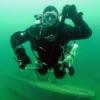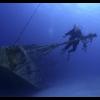Divers in the south are often accused of not understanding their diving brethern in the northeast. To be fair, I have never done diving in the northeast, but have some friends who do. However, they seem to dive with a different set of gear than the more common NE Wreckers. In an effort to better understand the diving I'd like to ask a few questions. So if you don't mind, I have a few itemized questions for you.
1. Did you happen to test your wing lift by actually using weights? I am aware some manufacturers under or overrate their wings. I was just wondering if you had tested yours.
2. On a dive to say, 120ft, what "stuff" do you carry? Can you offer an itemized list of things you take with you.
3. What is your exposure suit, and undergarment for the "average NE wreck dive".
4. What is your average run time on a NE Wreck Dive. Here the boats tend to limit us to about an hour.
5. When you dive, are you taking things off wrecks and if so, do you bring a lift bag for them?
6. Lastly, why do feel you need large steel tanks for doing a wreck dive in what is essentially, very close to recreational depths? I would think, perhaps foolishly, that a set of Aluminum 80s would be far preferable for ocean dives. I know that's what I am taking to the Oriskany.
Thanks
As one who actually dives here in the NE, I would like to add a few thoughts:
First, I don't believe the numbers that manufacturers claim. They're useful only in telling you that a higher number lifts more than a lower number, not in telling you the actual number of pounds of lift.
Having said that, NE diving is mostly wrecks on a hard bottom. I don't think you need to worry about walls locally, so what you really need is enough lift to get you and your stuff off the bottom with your drysuit flooded, early in the dive while the tanks are still full, and therefore negative. Your stuff is going to include a backup of just about everything because the visibility stinks and if you drop it, you'll probably never see it again. 
Your stuff is also going to include double steel tanks, plus extra deco tanks if you are doing deco diving. Even without the deco tanks, a set of steel doubles will probably eliminate needing a weight belt. Flood the suit on top of that and you can see getting off the bottom is going to take some positive bouyancy. If you're wondering about flooded suits, just imagine you put a hole in your suit on the wreck.
My experience with this experiment at Dutch Springs, (fresh water) was a 50 lb wing would get me back to the surface, but I really had to fill the wing to do it. There did not seem to be a lot of excess capacity. I then tried an OMS 100 lb wing and it responded much better and felt like there was still room to do more if necessary, e.g. bring something or someone to the surface.
Now the numbers sound huge, but if you assume that these wings only lift about half what they say they do, everything sort of comes in line with what you would expect.
The best thing to do is go to a place like Dutch Springs and try using a few wings and see how they feel.


















